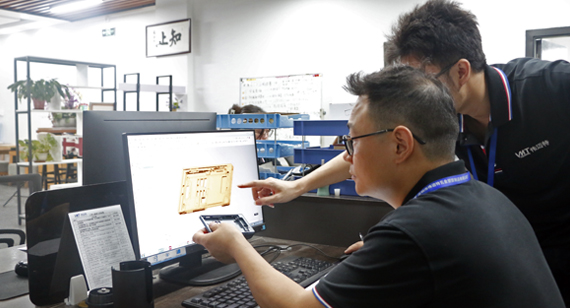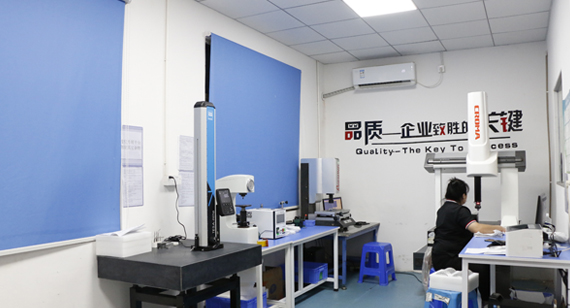15 years one-stop China custom CNC machining parts factory

Hey there I’m VMT Sam!
With 25 years of CNC machining experience we are committed to helping clients overcome 10000 complex part-processing challenges all to contribute to a better life through intelligent manufacturing. Contact us now
 115 |
Published by VMT at Feb 06 2024
115 |
Published by VMT at Feb 06 2024
CNC machining is an advanced manufacturing technology widely used across various industries. However, with increasing market competition, shortening lead time has become a significant challenge for manufacturers. Optimizing the CNC machining process is key to reducing lead time and improving production efficiency. This article explores how to optimize the CNC machining process to shorten lead time effectively.

1. Process Flow Analysis and Optimization
Firstly, conduct a comprehensive analysis of the existing CNC machining process flow, identifying bottleneck areas and inefficient steps. This includes evaluating processing times, tool selection, cutting parameters, and clamping methods for each step. Based on the analysis, take effective measures to optimize the process.
Tool and Cutting Parameter Optimization: Select appropriate tools and cutting parameters based on material characteristics, processing requirements, and tool performance. Through experimentation and accumulated experience, find the optimal cutting speeds, feed rates, and cutting depths to reduce processing time and enhance efficiency.
Process Flow Restructuring: Reorganize and optimize the existing process flow, adjusting processing sequences and consolidating adjacent steps. Eliminate redundancies and unnecessary steps to reduce waiting and idle time during the production process, improving overall production efficiency.
Introduction of New Technology and Equipment: Focus on and introduce advanced CNC machining technologies and equipment, such as high-speed cutting, multi-axis coordinated machining, and automated production lines. These new technologies and equipment significantly improve machining efficiency and accuracy, thus reducing processing cycles.

2. Process Parameter and Data Management
Establish a comprehensive process parameter and data management system to ensure the accuracy and consistency of process data, reducing errors and rework during production.
Development of Process Parameter Standards: Develop uniform standards for process parameters based on product characteristics and customer requirements. Ensure that processing parameters for each step meet the specified requirements, preventing quality issues arising from inconsistent parameters.
Data Recording and Traceability: Establish a data recording and traceability system to track and manage processing data for each part. Through data analysis, identify and address potential issues, enhancing the stability and reliability of the production process.
Quality Inspection and Control: Strengthen quality inspection and control procedures to ensure that the processing quality of each part meets requirements. Utilize appropriate inspection methods and tools to conduct online inspections and provide real-time feedback for key processes, promptly identifying and resolving issues, reducing defects, and rework rates.
3. Production Planning and Scheduling Management
Effectively plan and schedule production to ensure smooth production line operation, minimizing wait and idle times.
Balancing Production Load: Based on equipment capabilities and resource conditions, strategically plan production schedules to balance the load across production lines and equipment. Avoid delays and resource wastage caused by uneven equipment utilization.
Optimizing Scheduling Sequence: Optimize scheduling sequences based on production plans and delivery time requirements. Prioritize the production of urgent orders and critical components, and arrange production batches and quantities logically to enhance overall production efficiency.
Real-time Monitoring and Adjustment: Utilize production management systems to monitor production progress and equipment status in real-time. Promptly identify and resolve issues during the production process. Adjust production plans and schedules based on actual conditions to ensure on-time order completion.
4. Employee Training and Skill Enhancement
Strengthen employee training and skill enhancement to elevate the skill levels of operators and improve production efficiency.
Regular Training: Organize regular training sessions for employees, focusing on skill enhancement and safety education. Improve employees' operational skills and safety awareness, covering aspects such as new equipment operation, application of new processes, and quality consciousness.
Skills Competitions: Conduct skills competitions to motivate employees to learn and improve their skills actively. Recognize outstanding employees through competitions, set examples, and provide rewards to promote the overall improvement of employee skills.
Cross-department Collaboration and Communication: Enhance collaboration and communication between departments to facilitate information sharing and resource integration. By promoting cross-departmental cooperation, improve the efficiency and quality of problem-solving, boosting overall production efficiency.
5. Continuous Improvement and Innovative Development
Encourage continuous improvement and innovative development to consistently optimize the CNC machining process, enhancing production efficiency and product quality.
Experience Summarization and Sharing: Encourage employees to summarize practical experience and share success stories and improvement measures. Through collective wisdom and experience sharing, continuously optimize process flows and technological levels.
Innovation Practices and Applications: Keep an eye on industry trends and technological innovations, encouraging employees to actively try new process methods and technological applications. Reward and support practices and innovations that yield significant results, promoting continuous development.
Supply Chain Coordination: Strengthen collaboration with suppliers and customers to jointly optimize supply chain management. By sharing information, coordinating plans, and implementing a rapid response mechanism, reduce the risk of delays in the supply chain, improving overall delivery speed.
Automation and Intelligence: Promote the development of CNC machining automation and intelligence, introducing smart manufacturing technologies and industrial robots. Through automated production lines and intelligent monitoring systems, enhance the adaptability and reliability of the production process, reduce manual intervention and human errors, further shortening lead times and improving production efficiency.
Green Manufacturing and Sustainable Development: Emphasize environmental protection and sustainable development during process optimization. Adopt environmentally friendly materials, energy-saving technologies, and clean production methods to reduce energy consumption and emissions, minimizing resource wastage. Additionally, strengthen the recycling and disposal of waste materials.
6. Process Verification and Quality Assurance
To ensure the effectiveness of process optimization, conduct rigorous process verification and quality assurance.
Process Verification: During the process optimization, conduct multiple rounds of process verification to ensure the reliability and stability of optimized process parameters and workflows. Compare the results before and after optimization, evaluating the practical effectiveness of the optimization.
Quality Assurance: Establish a robust quality assurance system to continuously monitor the optimized process. Through regular quality inspections, process control, and data analysis, promptly identify and address potential issues, ensuring the stability and consistency of product quality.
Feedback and Improvement: Collect feedback information during the production process and continuously improve the process optimization. For quality issues and technical bottlenecks, conduct in-depth analysis and improvement, continually refining process flows and technological levels.

By implementing these comprehensive measures, CNC machining manufacturers can effectively optimize the process, shorten lead times, and improve production efficiency. Additionally, focusing on after-sales service and customer relationship management is crucial for handling customer feedback and complaints promptly, enhancing customer satisfaction and loyalty. Through continuous improvement and innovative development, CNC machining manufacturers can maintain a competitive edge in the intense market competition and achieve sustainable development.
Ready To Start Your Next Project?
Get Instant Quote

Request a Free Quote
Send us a message if you have any questions or request a quote. We will get back to you ASAP!